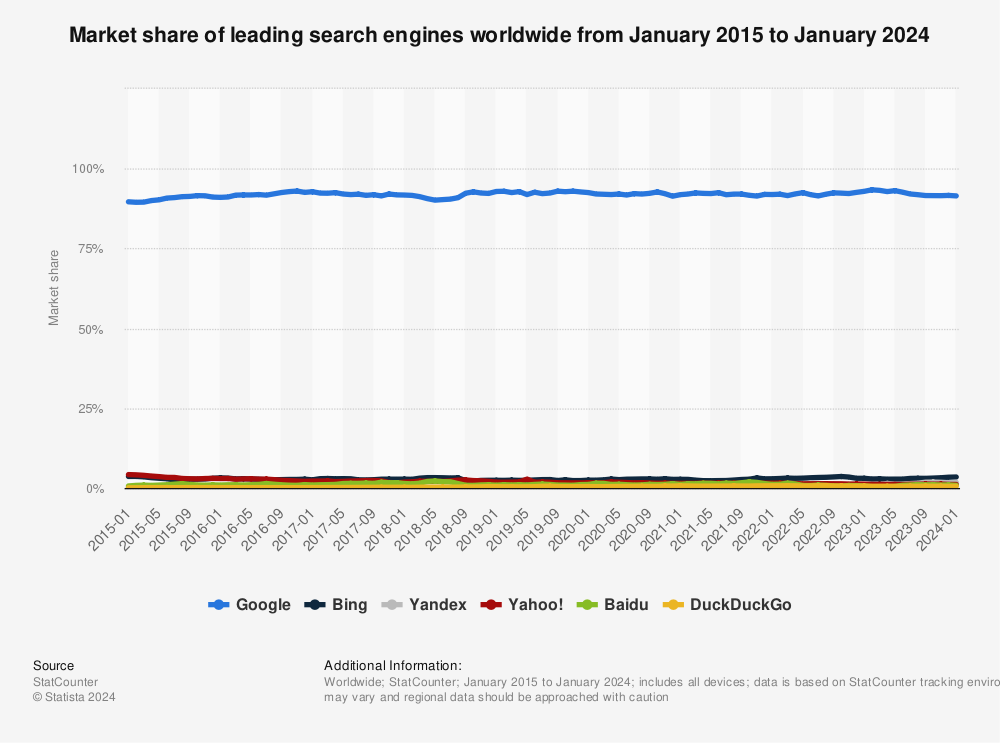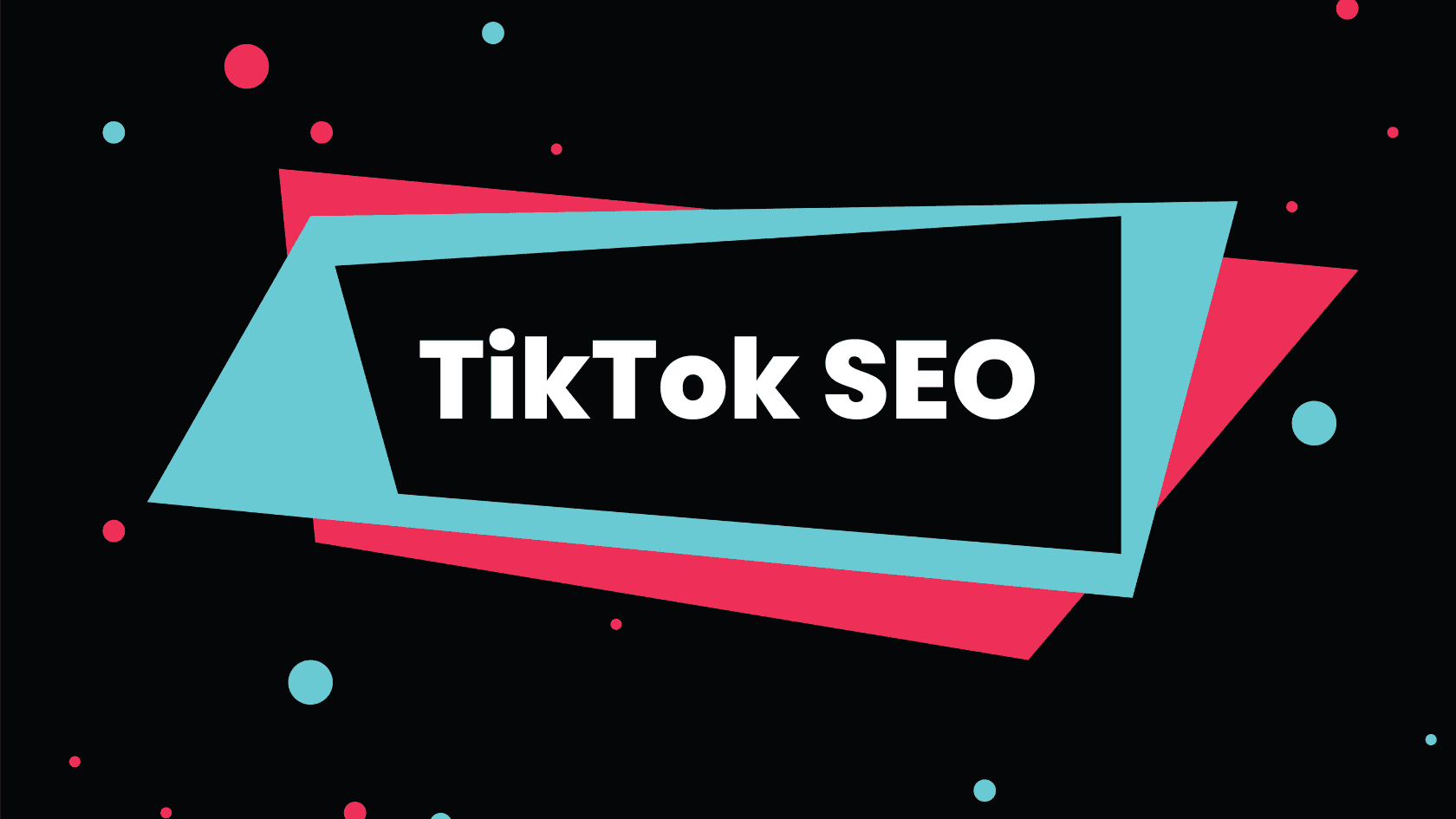While Google remains a dominant force, the evolution of search engines like TikTok, YouTube, and SearchGPT presents unique and exciting opportunities for visibility and engagement.
This article comprehensively reviews these search engines and platforms, empowering you to make informed marketing decisions that best align with your business goals.
It’s crucial to deeply understand the traditional search engine landscape to ensure you’re well-prepared for the digital future.
The Dominance of Google
Google’s dominance in the search engine market is unparalleled. With a market share exceeding 90% globally (Statista, 2024), it is the go-to platform for most internet users.
Google’s market dominance stems from its sophisticated algorithms, which provide highly relevant search results. Its vast index and robust advertising solutions, including Google Ads and Google My Business, allow businesses to effectively target and reach potential customers.
Google Ads: Offers various ad formats, including search ads, display ads, and video ads, which can be tailored to specific audiences.
Google My Business: Enhances local visibility by helping businesses appear in search results and Google Maps.
Google Analytics: Provides comprehensive insights into website traffic and user behaviour.
Google Search Console: Monitor and improve your website’s presence in Google search results.
Despite its dominance, relying solely on Google might limit your reach. Exploring alternative platforms can complement your Google strategy and help you tap into different audience segments.
The Evolution of Search Engines
While Google’s dominance in the search engine market is well-established, several alternative search engines have emerged, each offering unique features that cater to specific user preferences. These alternatives provide different user experiences and present valuable opportunities for businesses looking to diversify their digital strategies. Understanding the distinctive benefits of these platforms can help you leverage them effectively to complement your Google-centric approach.
Bing: A Robust Alternative with Unique Integration
Bing, Microsoft’s search engine, commands a more minor but notable share of the search market. Despite its smaller footprint compared to Google, Bing offers several advantages that make it a significant player:
Bing Ads provides competitive advertising solutions that can be an attractive alternative to Google Ads. Its platform offers cost-per-click (CPC) rates that are often lower than Google’s, which can reduce businesses’ advertising costs. Additionally, Bing’s targeting options, such as demographic and geographic targeting, allow for precise audience segmentation.
Bing is known for its rich visual experience, including daily background images and a visually appealing search results page. Features like Bing’s image search and video preview capabilities can enhance user engagement and offer businesses different ways to showcase their content.
DuckDuckGo: Privacy-Focused Search for the Modern User
DuckDuckGo has emerged as a prominent alternative by addressing a growing concern among users: privacy. Its appeal lies in its commitment to protecting user data:
DuckDuckGo is renowned for its strong privacy stance. Unlike other search engines, it does not track user activity, store personal data, or create user profiles. This approach resonates with users increasingly concerned about data privacy and online security.
It also provides a clean, straightforward search experience without personalised search results based on past behaviour. This can attract users who prefer unbiased search outcomes and greater control over their data.
DuckDuckGo offers valuable features such as Bangs, which allow users to quickly search other websites directly from DuckDuckGo. This can enhance the efficiency of searches and provide users with a seamless experience across the web.

Emerging Platforms and Their Search Capabilities
TikTok: The New Frontier for Search
TikTok has rapidly transformed from a social media platform into a significant player in the digital search landscape. Its unique content discovery and engagement approach presents new opportunities for businesses looking to expand their reach beyond traditional search engines. Unlike conventional search engines that rely heavily on keyword-based queries, TikTok’s search and discovery model is driven by user interaction and algorithmic recommendations.
Short-Form Content Search
TikTok’s Discovery Model: At the heart of TikTok’s search functionality is its innovative ‘For You’ page. This page is a personalised feed of recommended content powered by an advanced recommendation algorithm. The algorithm prioritises user engagement metrics—likes, shares, and comments—over traditional keyword relevance. As a result, content that resonates with users can quickly gain traction, making TikTok an effective platform for reaching new and diverse audiences through engaging, short-form videos.
User-Centric Recommendations: The ‘For You’ page curates content based on user preferences and interactions, creating a highly personalised viewing experience. This model allows businesses to tap into trending topics and viral challenges, effectively placing their content in front of users who are most likely to engage with it.
Content Creation Opportunities: Businesses can leverage TikTok’s format by creating captivating short-form videos that align with current trends and user interests. The platform’s emphasis on creativity and authenticity offers a unique opportunity to connect with users more organically and engagingly.
Business Opportunities
Viral Potential: One of TikTok’s standout features is its ability to propel content into viral status almost overnight. This means that content on TikTok has a high potential to be widely shared and viewed, often beyond the creator’s immediate network. The platform’s algorithm favours content that engages users and generates high levels of interaction. This characteristic allows businesses to create impactful marketing campaigns that can quickly gain widespread attention.
Viral Marketing Campaigns: Businesses can leverage TikTok’s viral potential to enhance brand visibility and engage with a broader audience by tapping trending hashtags, participating in viral challenges, or creating relatable and shareable content.
Advertising Solutions: TikTok provides a range of advertising options designed to integrate seamlessly with its user experience, offering businesses innovative ways to connect with users. These include In-Feed Ads, TopView Ads, Branded Hashtag Challenges, and Branded Effects.
In-Feed Ads: These ads appear in users’ ‘For You’ feed and are designed to blend in with organic content, offering a non-intrusive way to reach potential customers.
TopView Ads: TopView ads are full-screen advertisements that appear when users first open the app, ensuring maximum visibility and engagement.
Branded Hashtag Challenges: This format encourages users to participate in branded challenges, creating a sense of community and engagement around your brand while driving user-generated content.
Branded Effects: Allows businesses to create interactive filters and effects that users can incorporate into their videos, enhancing brand interaction and creativity.
TikTok SEO
TikTok has revolutionised the way content is discovered and consumed on social media. Understanding and implementing TikTok SEO (Search Engine Optimisation) strategies is essential to harness the platform’s full potential. Unlike traditional search engines that rely on keywords, technical SEO, and metadata, TikTok SEO optimises content for engagement and visibility within the platform’s unique algorithmic environment.
Understanding TikTok’s Algorithm
TikTok’s algorithm is central to its SEO strategy, as it determines which videos appear on users ‘For You’ pages and in search results. The algorithm evaluates various factors to curate a personalised content feed for each user:
TikTok’s algorithm prioritises videos that generate high levels of user interaction, including likes, comments, shares, and watch time. The algorithm is more likely to promote engaging content that resonates with viewers.
The algorithm considers how often users watch a video in its entirety. Videos that retain viewers’ attention throughout are favoured and more likely to be recommended.
TikTok’s algorithm also considers how well a video aligns with current trends and popular hashtags. Content that taps into trending topics and challenges is more likely to be surfaced to a broader audience.
Key Elements of TikTok SEO
Optimising Video Descriptions and Hashtags
Crafting compelling and relevant video descriptions is crucial for TikTok SEO. Include key terms related to your content, and use language encouraging user interaction. While descriptions should be engaging, they must also be concise and relevant to maintain viewer interest.
Effective use of hashtags can significantly enhance your video’s visibility. Research trending hashtags and incorporate them strategically into your posts. Use a mix of popular and niche-specific hashtags to reach both broad and targeted audiences.
Leveraging TikTok Trends and Challenges
Engaging with trending topics and challenges can boost your content’s visibility. TikTok’s trend discovery page is a valuable resource for identifying current trends that align with your brand.
Tailor your content to fit within trending themes while maintaining your brand’s voice and message. Trend-driven content has a higher chance of going viral, which can increase your reach and engagement.
Engaging Visuals and Captions
Ensure your videos are visually appealing and of high quality. Use eye-catching thumbnails and vibrant visuals to capture viewers’ attention.
Incorporate captions and text overlays to make your content more accessible and engaging. Clear, concise captions can enhance user understanding and encourage interaction.
Encouraging User Interaction
Include clear CTAs in your videos to prompt viewers to like, comment, share, or follow. Engaging CTAs can drive user interaction and improve your video’s performance within the algorithm.
Respond to comments and engage with users who interact with your content. Building a community around your videos can enhance engagement and foster a loyal audience.
Measuring and Adapting Your TikTok SEO Strategy
Analytics and Insights
Use TikTok’s built-in analytics tools to monitor your video performance. Key metrics include views, likes, shares, comments, and watch time. Analyse these metrics to understand what content resonates with your audience.
Regularly track the performance of your videos and adjust your SEO strategies based on what works best. Identifying patterns and trends in your analytics can guide future content creation.
Adapting to Algorithm Changes
TikTok’s algorithm and features are constantly evolving. Stay updated on platform changes and adapt your SEO strategy to maintain optimal performance.
Continuously experiment with different content formats, hashtags, and engagement strategies. Iterating based on performance data can help refine your approach and enhance your results.

YouTube: Beyond Video Hosting
YouTube’s role extends beyond video hosting; it is a powerful search engine in its own right.
YouTube’s algorithm prioritises user engagement metrics such as watch time and interaction rates. The platform’s recommendation system also plays a key role in content discovery (Search Engine Land, 2024).
SEO for YouTube
YouTube stands out not only as a platform for video hosting but also as a powerful search engine. With billions of users and an intricate recommendation system, optimising your YouTube content for search is crucial for achieving visibility and engagement.
Unlike traditional search engines, which rely heavily on keywords, YouTube’s algorithm considers various factors, such as viewer engagement, watch time, and content relevance.
Mastering YouTube SEO involves understanding these unique elements to ensure your videos are discoverable and appealing to your target audience.
Effective optimisation involves using relevant keywords in titles, descriptions, and tags. High-quality thumbnails and engaging video content are essential for attracting viewers.
Regular interaction with viewers through comments and encouraging subscriptions can enhance your channel’s visibility.
SearchGPT: Pioneering the Future of Conversational Search
SearchGPT marks a revolutionary step forward in conversational artificial intelligence, offering a transformative approach to user interaction with search technologies. By harnessing the power of advanced natural language processing (NLP), SearchGPT introduces a new level of depth and nuance to search experiences, reshaping how information is retrieved and presented.
What is SearchGPT?
SearchGPT represents a cutting-edge evolution in AI-driven search technology. Unlike traditional search engines that rely on straightforward keyword matching, SearchGPT employs sophisticated NLP algorithms to deliver search results that are both contextually relevant and highly nuanced. This conversational model enables a more dynamic and engaging search experience, where interactions are not limited to simple queries but extend to rich, context-aware conversations.
SearchGPT’s advanced algorithms are designed to grasp the subtleties of user queries, understanding intent and context rather than just individual keywords. This results in more accurate and meaningful search results that address users’ specific needs and preferences.
SearchGPT’s conversational nature allows users to engage in a back-and-forth dialogue with the search system. This interactive approach can refine searches in real time, offering progressively better answers based on the evolving context of the conversation.
Implications for Businesses
1. Enhancing Customer Service with AI Integration
Businesses can leverage SearchGPT’s capabilities to develop more sophisticated AI chatbots and virtual assistants. These advanced systems can provide more accurate and helpful responses, improving the overall customer service experience. By integrating conversational AI into customer support, businesses can offer a more personalised and efficient service that efficiently addresses complex queries.
Beyond chatbots, SearchGPT can enhance various support systems by offering real-time, contextually relevant assistance. This integration can streamline customer interactions, reduce response times, and increase overall satisfaction.
2. Improving Personalisation and Engagement
SearchGPT’s conversational abilities enable businesses to deliver more tailored responses to user queries. This level of personalisation can lead to higher engagement rates, as users receive answers that are more aligned with their specific needs and interests.
By providing a more interactive and responsive search experience, SearchGPT can enhance user engagement. The ability to hold meaningful conversations and adapt to user inputs creates a more immersive and satisfying experience, fostering stronger connections between businesses and their audiences.
“AI search is going to become one of the key ways that people navigate the internet, and it’s crucial, in these early days, that the technology is built in a way that values, respects, and protects journalism and publishers. We look forward to partnering with OpenAI in the process, and creating a new way for readers to discover The Atlantic.”Nicholas Thompson, CEO of The Atlantic
Choosing the Right Platform for Your Business
Evaluating Your Business Needs
Selecting the most suitable search engine or platform involves assessing your business goals and audience.
Identify where your target audience is most active. For example, younger users may prefer TikTok, while YouTube attracts a broader demographic. Understanding your audience’s preferences helps you choose the right platform.
Match your content strategy to the platform’s strengths. TikTok is ideal for short, viral videos, while YouTube is better suited for detailed, in-depth content. Aligning your content with the platform’s features can enhance your reach.
Integrating Multiple Platforms
A multi-channel strategy can maximise your online presence by leveraging the strengths of different platforms.
Cross-Platform Strategies: Develop a strategy integrating multiple platforms to reach diverse audiences. For instance, YouTube can be used for educational content, and TikTok can be used for quick, engaging promotions.
Measuring Success: Track and analyse performance across platforms using metrics such as engagement rates, traffic sources, and conversion rates. This data-driven approach allows you to refine your strategy based on what delivers the best results.

📷: OpenAI SearchGPT
Wrapped: The Evolution of Search Engines
Embracing a Multi-Channel Approach
While Google remains a dominant force, understanding and leveraging alternative search engines like Bing, DuckDuckGo and emerging platforms such as TikTok and SearchGPT can provide valuable opportunities for growth and engagement.
Embrace Diversity in Search Engines
Microsoft’s Bing offers a unique blend of integration with Windows devices and competitive advertising solutions. Its visual and interactive features allow businesses to engage users through cost-effective ad placements and rich media content.
With its strong emphasis on privacy, DuckDuckGo appeals to users who prioritise data security. Businesses can benefit from incorporating this search engine into their strategy to reach privacy-conscious audiences.
Leverage TikTok’s Innovative Search Capabilities
TikTok’s ‘For You’ page and algorithm-driven discovery model offer new ways to engage users through creative, short-form content. Businesses can utilise trending hashtags and participate in viral challenges to enhance their reach and visibility.
TikTok’s diverse ad formats, including In-Feed Ads, TopView Ads, and Branded Hashtag Challenges, provide innovative methods for businesses to connect with users and drive engagement.
Adopt Advanced Conversational Search Technologies
Representing the future of conversational AI, SearchGPT enhances search experiences with its advanced natural language processing. Its ability to deliver contextually relevant and nuanced results makes it a powerful tool for businesses to improve customer service through AI-driven chatbots and support systems.
SearchGPT’s conversational nature allows for more tailored responses, leading to better user engagement and satisfaction. By integrating this technology, businesses can offer more personalised interactions and foster stronger connections with their audience.
Final Thoughts
By exploring and integrating a range of search engines and innovative technologies, businesses can enhance their digital strategies and reach new audiences. From the visual allure of Bing to the privacy focus of DuckDuckGo, the dynamic content opportunities on TikTok, and the conversational prowess of SearchGPT, leveraging these platforms effectively can lead to greater visibility, engagement, and, ultimately, success in the digital realm.
“It’s not just about finding the best search engine; it’s about understanding how each platform can serve your unique business needs and amplify your reach. Embrace the diversity of digital search to stay ahead and connect with your audience more effectively.” — Tom, Founder at BQC
Embrace these advancements, stay informed about emerging trends, and continually adapt your strategies to stay ahead in this ever-changing environment.





